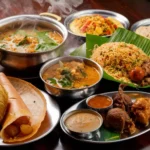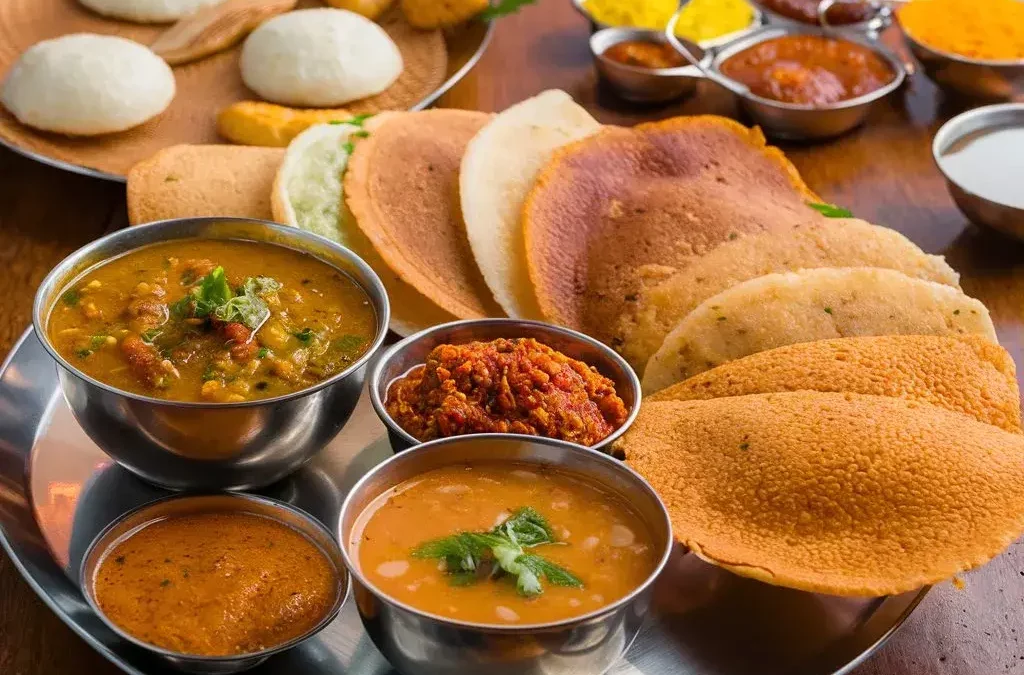
Traditional Indian Appetizers: The Best of Samosas, Pakoras, and Paneer Tikka
July 18, 2024
Spices Used in South Indian Cuisine: A Guide to Aromatic Flavors
August 9, 2024In the rich tapestry of South Indian cuisine, staple foods such as rice and lentils not only offer sustenance but also embody the cultural and agricultural ethos of the region. Rice, in its myriad forms—from the fragrant Basmati to the robust red rice—serves as the perfect canvas for the bold and complex flavors characteristic of Southern Indian food dishes. Lentils, equally pivotal, provide a foundational protein source, ingeniously incorporated into everything from crispy dosas to hearty sambar. Exploring these staples reveals a deeper narrative about tradition, adaptation, and the ingenious ways that South Indians maximize local ingredients. Yet, one might wonder, what other elements and influences converge on the plate to distinguish these everyday foods as culinary staples?
Exploring Rice and Its Varieties
Rice, a cornerstone of South Indian cuisine, is cultivated in diverse varieties, each with a unique aroma, texture, and culinary application. Among the most cherished is the aromatic Basmati, long and slender, often reserved for special occasions like weddings and festivals. Its fragrance, when cooked, is reminiscent of sun-baked earth and fresh rain, evoking a sense of homecoming and celebration.
Equally pivotal is Sona Masoori, a medium-grain rice that is lighter and fluffier, preferred for everyday meals. It serves as the perfect backdrop for robust South Indian curries and sambar, absorbing their flavors while maintaining its distinct texture. In the steamy kitchens of Tamil Nadu and Andhra Pradesh, it’s not just a food; it’s a gesture of hospitality, love, and community.
Further south, the robust red rice varieties, with their nutty flavor and higher nutritional value, are integral to Kerala’s dietary regimen. When cooked, red rice turns a deep pink, adding a splash of color to the plate and offering a rustic, hearty base for the coconut-laden dishes of the region.
Each grain of rice tells a story of the land it came from, connecting those who partake with their heritage and with each other.
The Versatility of Lentils
Continuing our journey through the staples of South Indian cuisine, lentils emerge as another foundational ingredient, celebrated for their versatility and nutritional richness. Integral to the culinary landscape of South India, lentils are not only a source of protein but also embody the essence of comfort in every meal. They are adeptly used in a myriad of dishes that resonate with the warmth of home.
Lentils are transformed in South Indian kitchens into various forms—each dish telling its own unique story. Take, for example, ‘sambar’, a hearty lentil-based stew that marries spices with vegetables and tamarind, offering a balance of tangy and savory flavors that are quintessentially South Indian.
Then there’s ‘dosa’, where lentils are ground and fermented to create thin, crisp crepes served with chutneys and sambar, making a perfect breakfast or snack.
Each preparation of lentils is a testament to the creativity of South Indian cooking, which is all about blending spices and textures to craft dishes that not only nourish the body but also comfort the soul. The humble lentil, thus, is not just food; it’s a celebration of tradition and community, inviting everyone to partake in its rich, culinary heritage.
In conclusion, the staple foods of South India, encompassing rice, lentils, and a rich tapestry of spices and vegetables, form the bedrock of Indian food tradition.
This gastronomic landscape, punctuated by ancient grains like millets, not only narrates the history of a vibrant culture but also underscores the ingenuity and sustainability inherent in South Indian cooking.
As such, these staples do more than nourish; they weave a continuous thread through the fabric of social and cultural identity in the region.

